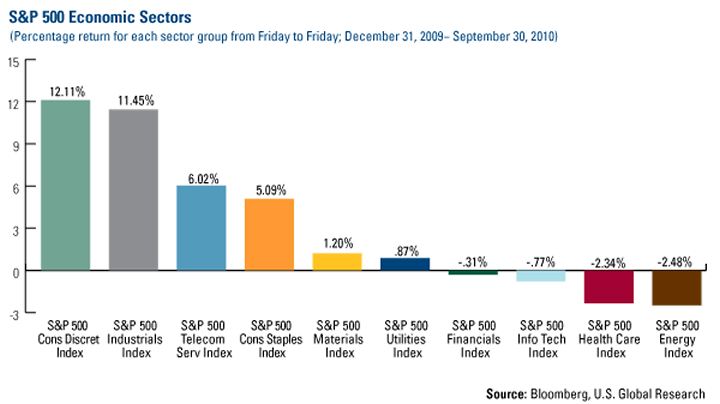How Government Policies Affect the Stock Market
Stock-Markets / Stock Markets 2010 Oct 09, 2010 - 07:12 AM GMTBy: Frank_Holmes

 One key element of our investment process at U.S. Global Investors is tracking and monitoring government policies. We believe policies are precursors to changes in the marketplace and taking a look at year-to-date performance of the S&P 500 Index is a good way to illustrate how.
One key element of our investment process at U.S. Global Investors is tracking and monitoring government policies. We believe policies are precursors to changes in the marketplace and taking a look at year-to-date performance of the S&P 500 Index is a good way to illustrate how.
This chart shows the year-to-date performance for each sector of the S&P 500 through the end of the quarter. Consumer discretionary (up 12.11 percent) and industrials (up 11.45 percent) have been far and away the top performers, nearly doubling third place telecom, while energy (down 2.34 percent) and healthcare (down 2.48) are the worst performers.

The performance of both the best and worst sectors can be traced back, at least in part, to government policies.
Consumer discretionary has drawn much of its performance from the auto retail sector which is up almost 45 percent. One driver has been better-than-expected auto sales but another was Toyota’s recalls and the resulting Congressional investigation. Toyota’s fall has been Ford’s and other domestic manufacturers’ gain as they have wrestled back market share from foreign companies.
Rising overseas sales for construction and farming equipment manufacturers such as Caterpillar and Deere have buoyed industrials. Investors have flocked to telecom, which is represented by AT&T and Verizon, as an income play since the current dividends for those companies are yielding 5-6 percent.
Energy and healthcare have felt the sting of government policies. Uncertainty about healthcare reform has kept providers and pharmaceutical companies at depressed levels. For energy, the BP disaster and ensuing drilling moratorium took down the drillers, suppliers and producers. Like the Gulf Coast, the sector has yet to recover and government officials have given no indication as to when the drilling ban will be lifted.
Possible quantitative easing (QE) measures have led to the run-up in materials. The market’s anticipation of these measures has been commodity positive and dollar negative. We think this could be one of the best sectors during the fourth quarter but there is a risk of a pullback if QE measures don’t meet market expectations.
The following securities mentioned in the article were held by one or more of U.S. Global Investors family of funds as of June 30, 2010: Caterpillar, Verizon Communications, AT&T. The S&P 500 Stock Index is a widely recognized capitalization-weighted index of 500 common stock prices in U.S. companies. The S&P 500 Energy Index is a capitalization-weighted index that tracks the companies in the energy sector as a subset of the S&P 500. The S&P 500 Materials Index is a capitalization-weighted index that tracks the companies in the material sector as a subset of the S&P 500. The S&P 500 Financials Index is a capitalization-weighted index. The index was developed with a base level of 10 for the 1941-43 base period. The S&P 500 Industrials Index is a Materials Index is a capitalization-weighted index that tracks the companies in the industrial sector as a subset of the S&P 500. The S&P 500 Consumer Discretionary Index is a capitalization-weighted index that tracks the companies in the consumer discretionary sector as a subset of the S&P 500.
The S&P 500 Information Technology Index is a capitalization-weighted index that tracks the companies in the information technology sector as a subset of the S&P 500. The S&P 500 Consumer Staples Index is a Materials Index is a capitalization-weighted index that tracks the companies in the consumer staples sector as a subset of the S&P 500. The S&P 500 Utilities Index is a capitalization-weighted index that tracks the companies in the utilities sector as a subset of the S&P 500. The S&P 500 Healthcare Index is a capitalization-weighted index that tracks the companies in the healthcare sector as a subset of the S&P 500. The S&P 500 Telecom Index is a Materials Index is a capitalization-weighted index that tracks the companies in the telecom sector as a subset of the S&P 500.
By Frank Holmes, CEO , U.S. Global Investors
Frank Holmes is CEO and chief investment officer at U.S. Global Investors , a Texas-based investment adviser that specializes in natural resources, emerging markets and global infrastructure. The company's 13 mutual funds include the Global Resources Fund (PSPFX) , Gold and Precious Metals Fund (USERX) and Global MegaTrends Fund (MEGAX) .
More timely commentary from Frank Holmes is available in his investment blog, “Frank Talk”: www.usfunds.com/franktalk .
Please consider carefully the fund's investment objectives, risks, charges and expenses. For this and other important information, obtain a fund prospectus by visiting www.usfunds.com or by calling 1-800-US-FUNDS (1-800-873-8637). Read it carefully before investing. Distributed by U.S. Global Brokerage, Inc.
All opinions expressed and data provided are subject to change without notice. Some of these opinions may not be appropriate to every investor. Gold funds may be susceptible to adverse economic, political or regulatory developments due to concentrating in a single theme. The price of gold is subject to substantial price fluctuations over short periods of time and may be affected by unpredicted international monetary and political policies. We suggest investing no more than 5% to 10% of your portfolio in gold or gold stocks. The following securities mentioned in the article were held by one or more of U.S. Global Investors family of funds as of 12-31-07 : streetTRACKS Gold Trust.
Frank Holmes Archive |
© 2005-2022 http://www.MarketOracle.co.uk - The Market Oracle is a FREE Daily Financial Markets Analysis & Forecasting online publication.


